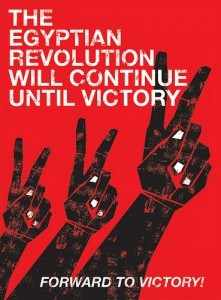From Dictatorship to Democracy
New Visions for Egypt’s Ongoing Revolution
By Sherif Joseph Rizk (adapted from an interview with Matt Meyer)
There are many myths about the Egyptian Revolution — first and foremost that it was a success story based completely on the principles of strategic nonviolence. The main fact is that, though it was a mostly nonviolent effect, our only success was in getting rid of the dictator. The rule of the dictatorship, however, continues.
 It is important to understand that during the uprisings of 2011, there were elements of confrontation that could be considered “borderline violence†— if you consider throwing back tear gas canisters or Molotov cocktails violent. There was plenty of that. I think there is a threshold that has to do with the proportionate use of force: if the force that is used to counter the opposite force is proportionate, it may not be appropriate to deem that force as violent. In the case of Egypt since 2011, I would say that the force used against the security state was disproportionately small, and therefore, by my standards, should be considered nonviolent. To confront a security state, one needs to throw back tear gas canisters, and though I wasn’t personally involved in those activities, I was close to others who were. I don’t think that’s violent — it is part of the ground tactics needed in confronting a security state.
It is important to understand that during the uprisings of 2011, there were elements of confrontation that could be considered “borderline violence†— if you consider throwing back tear gas canisters or Molotov cocktails violent. There was plenty of that. I think there is a threshold that has to do with the proportionate use of force: if the force that is used to counter the opposite force is proportionate, it may not be appropriate to deem that force as violent. In the case of Egypt since 2011, I would say that the force used against the security state was disproportionately small, and therefore, by my standards, should be considered nonviolent. To confront a security state, one needs to throw back tear gas canisters, and though I wasn’t personally involved in those activities, I was close to others who were. I don’t think that’s violent — it is part of the ground tactics needed in confronting a security state.
Fortress Tahrir, during the 18 days when the square was occupied by the Egyptian people, faced many complicated tactical issues. One was how it might best be defended; it was being attacked on many levels by all sorts of challenges. (more…)






